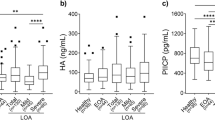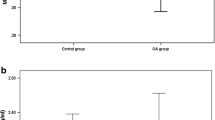Abstract
Background and aim
Apolipoprotein D (ApoD) is a 25–30 kDa glycoprotein, as a distinct component of the human plasma lipoprotein system. Its known biological functions are mainly related to lipid metabolism. The purpose of this study was to explore the potential role of ApoD concentration in knee osteoarthritis (KOA).
Methods
This study was performed in a population of 113 KOA subjects and 97 healthy controls. Serum ApoD was detected using the commercial ELISA kit (Cusabio, Wu Han, China, Cat No. CSB-EL001935HU). Radiographic progression was evaluated using Kellgren–Lawrence (KL) classification. The clinical severity of KOA was assessed by visual analog score (VAS), Hospital for special surgery (HSS) knee score disease duration and TNF-α. Receiver-operating characteristic (ROC) curve was performed to test the potential diagnostic value of ApoD in radiographic progression.
Results
The serum ApoD level of patients with KOA was significantly lower than that of healthy controls. The serum ApoD level was negatively correlated with KL grades, VAS score, disease duration, TNF-α concentrations. On the contrary, it was positively correlated with HSS score. However, there was no correlation between this serological indicator and which side was affected. ROC curve analysis indicated that attenuated serum ApoD could serve as an appropriate biomarker concerning the diagnosis of KOA.
Conclusions
Serum ApoD concentration was correlated with the presence and severity of KOA.





Similar content being viewed by others
Data availability
Relevant data are available from the corresponding author upon reasonable request.
References
Barroso J, Wakaizumi K, Reis AM, Baliki M, Schnitzer TJ, Galhardo V, Apkarian AV (2021) Reorganization of functional brain network architecture in chronic osteoarthritis pain. Hum Brain Mapp 42:1206–1222. https://doi.org/10.1002/hbm.25287
Lv ZT, Shen LL, Zhu B, Zhang ZQ, Ma CY, Huang GF, Yin J, Yu LL, Yu SY, Ding MQ, Li J, Yuan XC, He W, Jing XH, Li M (2019) Effects of intensity of electroacupuncture on chronic pain in patients with knee osteoarthritis: a randomized controlled trial. Arthritis Res Ther 21:120. https://doi.org/10.1186/s13075-019-1899-6
Bennell KL, Nelligan RK, Kimp AJ, Schwartz S, Kasza J, Wrigley TV, Metcalf B, Hodges PW, Hinman RS (2020) What type of exercise is most effective for people with knee osteoarthritis and co-morbid obesity?: The TARGET randomized controlled trial. Osteoarthritis Cartilage 28:755–765. https://doi.org/10.1016/j.joca.2020.02.838
Santoprete S, Marchetti F, Rubino C, Bedini MG, Nasto LA, Cipolloni V, Pola E (2021) Fresh autologous stromal tissue fraction for the treatment of knee osteoarthritis related pain and disability. Orthopedic Rev 13:9161. https://doi.org/10.4081/or.2021.9161
Deng P, Liang H, Xie K, Han J, Huang F, Liu H, Zhu H, Huang Z, Wu Q, Tao J, Li L, Chen Z (2021) Study on the molecular mechanism of Guizhi Jia Shaoyao decoction for the treatment of knee osteoarthritis by utilizing network pharmacology and molecular docking technology. Allergol Immunopathol 49:16–30
Li Z, Chen B (2021) DUSP4 alleviates LPS-induced chondrocyte injury in knee osteoarthritis via the MAPK signaling pathway. Exp Ther Med 22:1401. https://doi.org/10.3892/etm.2021.10837
Wang S, Ding P, Xia X, Chen X, Mi D, Sheng S, Gu F, Li Z, Su K, Li Y (2021) Bugan Rongjin decoction alleviates inflammation and oxidative stress to treat the postmenopausal knee osteoarthritis through Wnt signaling pathway. Biomed Eng Online 20:103. https://doi.org/10.1186/s12938-021-00939-8
Rassart E, Bedirian A, Do Carmo S, Guinard O, Sirois J, Terrisse L, Milne R (2000) Apolipoprotein D. Biochimica et Biophysica Acta (BBA) Protein Structure and Molecular Enzymology 1482:185–198. https://doi.org/10.1016/s0167-4838(00)00162-x
Qin Y, Li J, Zhou Y, Yin C, Li Y, Chen M, Du Y, Li T, Yan J (2021) Apolipoprotein D as a potential biomarker and construction of a transcriptional regulatory-immune network associated with osteoarthritis by weighted gene coexpression network analysis. Cartilage. https://doi.org/10.1177/19476035211053824
Altman R, Asch E, Bloch D, Bole G, Borenstein D et al (1986) Development of criteria for the classification and reporting of osteoarthritis. Classification of osteoarthritis of the knee. Diagnostic and Therapeutic Criteria Committee of the American Rheumatism Association. Arthritis Rheum 29:1039–1049. https://doi.org/10.1002/art.1780290816
Kohn MD, Sassoon AA, Fernando ND (2016) Classifications in brief: Kellgren-Lawrence classification of osteoarthritis. Clin Orthop Relat Res 474:1886–1893. https://doi.org/10.1007/s11999-016-4732-4
Yuan WH, Xie QQ, Wang KP, Shen W, Feng XF, Liu Z, Shi JT, Zhang XB, Zhang K, Deng YJ, Zhou HY (2021) Screening of osteoarthritis diagnostic markers based on immune-related genes and immune infiltration. Sci Rep 11:7032. https://doi.org/10.1038/s41598-021-86319-7
Tew SR, Clegg PD, Brew CJ, Redmond CM, Hardingham TE (2007) SOX9 transduction of a human chondrocytic cell line identifies novel genes regulated in primary human chondrocytes and in osteoarthritis. Arthritis Res Ther 9:R107. https://doi.org/10.1186/ar2311
Yu RH, Zhang XY, Xu W, Li ZK, Zhu XD (2020) Apolipoprotein D alleviates glucocorticoid-induced osteogenesis suppression in bone marrow mesenchymal stem cells via the PI3K/Akt pathway. J Orthop Surg Res 15:307. https://doi.org/10.1186/s13018-020-01824-1
Martineau C, Najyb O, Signor C, Rassart É, Moreau R (2016) Apolipoprotein D deficiency is associated to high bone turnover, low bone mass and impaired osteoblastic function in aged female mice. Metabolism 65:1247–1258. https://doi.org/10.1016/j.metabol.2016.05.007
Herr SA, Malek S, Rochat MC, Moore GE, Ko JC, Shi R (2021) Evidence of acrolein in synovial fluid of dogs with osteoarthritis as a potential inflammatory biomarker. BMC Musculoskelet Disord 22:894. https://doi.org/10.1186/s12891-021-04762-z
Hu N, Zhang J, Wang J, Wang P, Wang J et al (2021) Biomarkers of joint metabolism and bone mineral density are associated with early knee osteoarthritis in premenopausal females. Clin Rheumatol. https://doi.org/10.1007/s10067-021-05885-3
Yamamoto T, Miyaji N, Kataoka K, Nishida K, Nagai K, Kanzaki N, Hoshino Y, Kuroda R, Matsushita T (2021) Knee osteoarthritis progression is delayed in silent information regulator 2 ortholog 1 knock-in mice. Int J Mol Sci. https://doi.org/10.3390/ijms221910685
Cutcliffe HC, Kottamasu PK, McNulty AL, Goode AP, Spritzer CE, DeFrate LE (2021) Mechanical metrics may show improved ability to predict osteoarthritis compared to T1rho mapping. J Biomech 129:110771. https://doi.org/10.1016/j.jbiomech.2021.110771
Wu Q, Sun X, Du L (2017) Association of fibulin-3 concentrations with the presence and severity of knee osteoarthritis: a cross-sectional study. Knee 24:1369–1373. https://doi.org/10.1016/j.knee.2017.04.018
Alissa EM, Alzughaibi LS, Marzouki ZM (2020) Relationship between serum resistin, body fat and inflammatory markers in females with clinical knee osteoarthritis. Knee 27:45–50. https://doi.org/10.1016/j.knee.2019.12.009
Koh SM, Chan CK, Teo SH, Singh S, Merican A, Ng WM, Abbas A, Kamarul T (2020) Elevated plasma and synovial fluid interleukin-8 and interleukin-18 may be associated with the pathogenesis of knee osteoarthritis. Knee 27:26–35. https://doi.org/10.1016/j.knee.2019.10.028
Magaña JJ, Gálvez-Rosas A, González-Huerta C, Duarte-Salazár C, Lara-Alvarado L, Soria-Bastida MA, Cortés-González S, Miranda-Duarte A (2010) Association of the calcitonin gene (CA) polymorphism with osteoarthritis of the knee in a Mexican mestizo population. Knee 17:157–160. https://doi.org/10.1016/j.knee.2009.08.006
Dassati S, Waldner A, Schweigreiter R (2014) Apolipoprotein D takes center stage in the stress response of the aging and degenerative brain. Neurobiol Aging 35:1632–1642. https://doi.org/10.1016/j.neurobiolaging.2014.01.148
Ganfornina MD, Do Carmo S, Lora JM, Torres-Schumann S, Vogel M, Allhorn M, González C, Bastiani MJ, Rassart E, Sanchez D (2008) Apolipoprotein D is involved in the mechanisms regulating protection from oxidative stress. Aging Cell 7:506–515. https://doi.org/10.1111/j.1474-9726.2008.00395.x
Funding
No funding was received for this study.
Author information
Authors and Affiliations
Contributions
LB: experiment work, data analysis, and writing of the manuscript. WBF: research design, clinical design, review of the content, and project administration. ZHX, LJT, WXW, and CT: experiment work, data analysis. The authors read and approved the final manuscript.
Corresponding author
Ethics declarations
Conflict of interest
On behalf of all authors, the corresponding author states that there is no conflict of interest.
Ethical approval
Ethical approval was obtained from the institutional ethics and research committee. The participants in study were humans.
Informed consent
A written informed consent was obtained from all the participants.
Additional information
Publisher's Note
Springer Nature remains neutral with regard to jurisdictional claims in published maps and institutional affiliations.
About this article
Cite this article
Li, B., Zhan, H., Luo, J. et al. A novel serological biomarker are associated with disease severity in patients with osteoarthritis. J Bone Miner Metab 40, 1007–1013 (2022). https://doi.org/10.1007/s00774-022-01364-0
Received:
Accepted:
Published:
Issue Date:
DOI: https://doi.org/10.1007/s00774-022-01364-0




